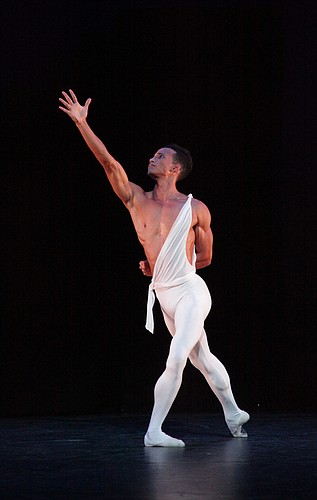- January 15, 2025
-
-
Loading

Loading

Sure, the Sarasota Ballet 2016-2017 season began at the end of October, with its performance of Walsh, Tudor, Graziano and Layton at the FSU Center for the Performing Arts. But there’s something to say about a show on the larger stage at the Sarasota Opera House performed to the live music of the Sarasota Orchestra: It just seems more significant.
And with the endurance and technique needed to pull off the three royal pieces on the program — George Balanchine’s “Apollo,” Sir Frederick Ashton’s “Sinfonietta” and Antony Tudor’s “Gala Performance” — the Sarasota Ballet had a lot to prove. The dancers, as we have seen many times before, accepted the challenge and delivered a practically perfect performance.
Although "Apollo" is usually performed without the opening scene of Apollo’s mother, Leto, giving birth to the Greek god of music, the Sarasota Ballet performed “Apollo” in its entirety, with guest conductor Jonathan McPhee ably leading the orchestra through the music by Igor Stravinsky.
Ricardo Rhodes danced the role of Apollo with masculinity, strength and precision, demonstrating the maturity he has gained as a dancer. He danced every step with a determined force, from multiple entrechat six jumps and turns to the simple movements of clasping and unclasping of hands.
Rhodes flexed his partnering skills while dancing with his muses, Amy Wood, Kristianne Kleine and Victoria Hulland. He would partner all three at once, forming intricate vignettes achieved by the female dancers, with arms intertwined and moving around him, often ending in a pose with the three female dancers in an arabesque penché.
During the pas de deux with Hulland, Rhodes held Hulland’s hands above in fifth position, while she slid into a split and back up into an arabesque en pointe. Kleine, dancing the role of Polyhymnia, the muse of mime, mastered the Balanchine style, pairing quick and lyrical movements during her solo. She was stunning during a double piqué turn sequence that ended into an arabesque plié while holding one finger up against her mouth as if she were being quiet — no easy feat.
Ashton’s “Sinfonietta,” set to music by Sir Malcolm Williamson, is a ballet consisting of three movements. The first movement, “Toccata,” and third movement, “Tarantella,” are lively and fast-paced, with the dancers in white tights and brightly striped tops. They sandwiched the second movement, “Elegy,” a more somber piece with one female, Ellen Overstreet, partnered by five men in all white.
Overstreet seemed to float mid-air while passed from partner to partner. At one point, all five men had Overstreet pressed above their heads, followed by the two lead men twisting down into a plié onto the floor on their backs and quickly rising. The scene created an impressive wave-like movement through Overstreet’s body.
In “Toccata” and “Tarantella,” Kate Honea and Alex Harrison and Nicole Padilla and Xavier Nunez proved to be the masters of allégro. Their feet barely touched the ground in between each small jump, making them appear mid-air throughout both movements. Ricardo Rhodes again commanded the floor in “Tarantella,” leading the entire cast in a lively culmination of the plotless, yet enjoyable ballet.
Tudor’s “Gala Performance,” set to Sergei Prokofiev’s “3rd Piano Concerto & Classical Symphony,” comes off early on as a spoof on the different styles of ballet (and its respective divas), eliciting laughter and giggles from the audience. But the choreography calls for some challenging dancing from the three divas representing Russia, Italy and France for the Gala Performance.
Kristianne Kleine was a powerhouse in her role as the Russian Ballerina, making sure everyone knew how difficult her choreography was by becoming stern-faced while performing tough tricks, such as a fouetté en tourant sequence, then breaking into a wide smile during easier poses.
Victoria Hulland milked her over-sized feather headpiece for dramatic effect while bossing around her Cavalier, Edward Gonzalez, on where to stand or catch her while holding poses in arabesque or in sur le cou-de-pied relevé. Kate Honea was full of frivolity during her pas de deux with Alex Harrison that included many jumps and turns, but was not without many kisses to the audience.
The three ballerinas capped the evening in the finale when they each tried to steal the limelight from the other. Even though these three divas were exquisite throughout, the corps de ballet and other cast members deserve recognition for completing a truly gala performance.